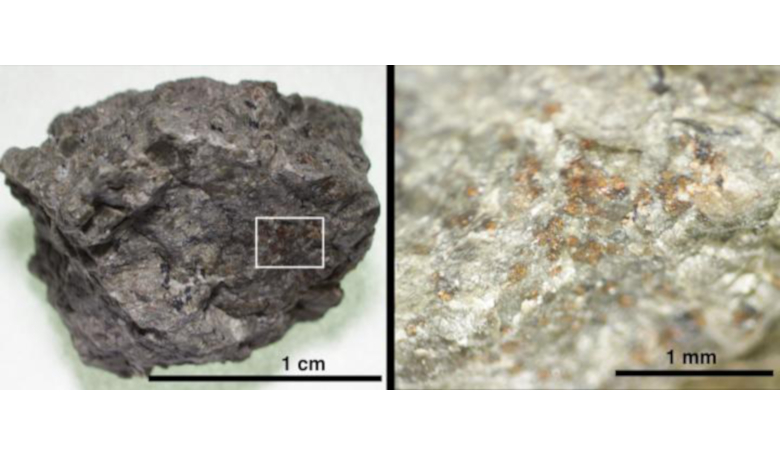A martian meteorite that crash landed in Antarctica has been found to contain nitrogen-bearing organic material, a finding which suggests that 4 billion years ago, Mars was once a wet and organic-rich planet which harboured the right conditions for life to start.
Nitrogen (N) is an essential element for all life. It is an important part of many cells and processes such as amino acids, proteins and even our DNA. Without it, humanity as we know it wouldn't exist. As such, like carbon, nitrogen is a useful tracer for understanding planetary evolution and finding it would be a major step forward in helping to determine how habitable a world may have been.
For decades, with the aid of meteorites and car-sized rovers trundling over the martian surface, scientists have been searching for organic compounds on Mars. Just last month, astrobiologists reported the discovery of an intriguing group of organic compounds found by the Curiosity rover in dried-up mud in the Gale Crater. Because sediment patterns show that a lot of water was present, continually, over many millions of years in Gale crater, the ancient impact site has become the go-to place for looking for signs of life - if it ever arose.
But how widely distributed and preserved these organics might be, or what their possible relationship with biochemical activity could be is still very much unknown.
Now, a rock that was thought to have been ejected from Mars' surface ~15 million years ago and was found on Earth 26 years ago, is helping scientists unravel more about past conditions on Mars’ now dry and barren terrain.
The meteorite, named Allan Hills (ALH) 84001, after the region in Antarctica it was found in, contains orange-coloured carbonate minerals, which precipitated from salty liquid water on Mars' near-surface 4 billion years ago.
The martian meteorite is well studied, but so far contamination with terrestrial material from Antarctic snow and ice, has made it difficult to determine how much of the organic material in the meteorite was truly Martian in origin.
However, after probing the meteorite with state-of-the-art analytical techniques, a joint team from the Earth-Life Science Institute (ELSI) at Tokyo Institute of Technology, Japan and research scientist Mizuho Koike from the Institute of Space and Astronautical Science at Japan Aerospace Exploration Agency (JAXA) say they are confident they have found the first solid evidence for 4-billion-year-old Martian organics containing nitrogen.
Before using a technique called Nitrogen K-edge micro X-ray Absorption Near Edge Structure (μ-XANES) spectroscopy to detect the nitrogen content of the ALH84001 carbonates, the ELSI-JAXA team first plucked off the tiny carbonate grains, which are about the width of a human hair, from the martian meteorite using silver tape in an ELSI clean lab.
Any possible surface contaminants were then removed with a scanning electron microscope-focused ion beam instrument to ensure the sample was not polluted with material that wasn’t of martian origin.
As an additional control, the team also analysed nearby igneous minerals to ascertain their chemical content - none of which showed signs of detectable nitrogen.
After all of the careful contamination checks, the team determined the organic molecules were only in the carbonate and therefore martian in nature. It is likely say the team that the minerals were trapped about 4 billion years ago and preserved for long periods before finally being delivered to Earth.
The team, who also includes research scientist Atsuko Kobayashi at ELSI also determined the contribution of nitrogen in the form of nitrate was insignificant, suggesting the early Mars was less-oxidising than it is today.
Oxidation is the process in which one atom strips electrons from another, claiming them for its own. The term draws its name from oxygen because it was the first known oxidative element. However, most elements can be oxidised and on Mars, nitrate (NO3) is currently one of the strong oxidating compounds. And because of the low levels of nitrogen gas in the atmosphere, nitrate is the only biologically useful form of nitrogen on Mars. Its presence therefore is of major astrobiological significance.
Nonetheless, its discovery in the Allan Hills (ALH) 84001 meteorite doesn’t solve the question of whether Mars was once inhabited or not and questions such as where did these nitrogen-containing organics come from, still remain.
'There are two main possibilities: either they came from outside Mars, or they formed on Mars. Early in the Solar System's history, Mars was likely showered with significant amounts of organic matter, for example from carbon-rich meteorites, comets and dust particles. Some of them may have dissolved in the brine and been trapped inside the carbonates,” explains Kobayashi.
Alternatively, chemical reactions on early Mars may have produced the N-bearing organics on-site says research team lead, Koike.
Either way, say the authors of the research paper submitted to Nature Communications, these findings show there was organic nitrogen on Mars before it became the cold, dried-up, and inhospitable planet we see today; “early Mars may have been more 'Earth-like', less oxidising, wetter, and organic-rich. Perhaps it was 'blue.'











